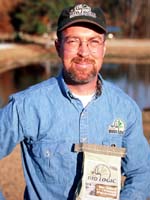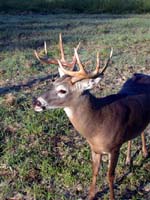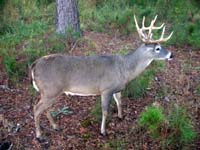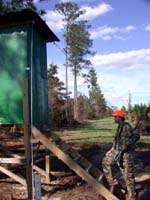HOW TO FIND AND TAKE TROPHY BUCKS IN THE EARLY SEASON
WITH DR. GRANT WOODS
 How
to Scout from the Skinning Shed How
to Scout from the Skinning Shed
Editor's Note: Dr. Grant Woods of Reeds Spring, Missouri,
one of the nation's leading white-tailed deer researchers,
not only has studied whitetails for many years but also
uses the latest scientific technology to track deer
movement and learn why deer do what they do. We've asked
Woods to tell our readers how to find the bucks of their
dreams this year.
First, I'll study the pressure hunting patterns in
the early season-which in many states includes bow hunting
and black-powder hunting for deer. Often at this time
of the year the bucks will be moving as though they're
not disturbed. I call a pressure hunting pattern any
hunting condition after the first day of modern gun
season. So, when you're hunting a pre-pressure pattern
like we often find during early deer season, the three
areas to concentrate on when you're looking for deer
are places where deer eat, drink and bed before the
rut, which means you should be hunting pre-rut food,
water and cover patterns for the most success. The deer
should be easier to pattern during the early season,
which should be one of the best times to take a trophy
buck. If we can accept these generalities, let's look
at some more-specific places to find a trophy early-season
buck.
To bag a big buck, we must start with the places a
trophy buck will be most of the time during the early
season. That older-age-class buck will be in what I
call a secure area where he doesn't believe he'll see
a hunter. Or, if he does spot a hunter, that buck believes
he can escape  before
the hunter sees or takes him. A secure area may be only
a small trash pile out in the middle of a 40-acre field
where the buck can stay and smell and see in all directions.
Or, the buck may have a little hidey-hole where hunters
rarely if ever think to look for a buck. Your chances
of finding a buck in his bed will be very slim because
he's picked his bedding spot knowing the hunter won't
be there. But I've learned from the studies I've done
that the most-effective way to discover a trophy buck
or a nice buck is to scout from the skinning shed. I've
learned this technique when my company, Woods and Associates,
has been called in to remove nuisance deer from golf
courses, airports and other places where deer cause
major problems for people. When we're called into areas
like this, we take the maximum number of deer we possibly
can take in the shortest time - we're not playing at
deer hunting. We must be extremely efficient and must
know exactly where and when to take the most deer. Therefore
when the first deer is taken, we immediately study what
the deer's been eating. before
the hunter sees or takes him. A secure area may be only
a small trash pile out in the middle of a 40-acre field
where the buck can stay and smell and see in all directions.
Or, the buck may have a little hidey-hole where hunters
rarely if ever think to look for a buck. Your chances
of finding a buck in his bed will be very slim because
he's picked his bedding spot knowing the hunter won't
be there. But I've learned from the studies I've done
that the most-effective way to discover a trophy buck
or a nice buck is to scout from the skinning shed. I've
learned this technique when my company, Woods and Associates,
has been called in to remove nuisance deer from golf
courses, airports and other places where deer cause
major problems for people. When we're called into areas
like this, we take the maximum number of deer we possibly
can take in the shortest time - we're not playing at
deer hunting. We must be extremely efficient and must
know exactly where and when to take the most deer. Therefore
when the first deer is taken, we immediately study what
the deer's been eating.
If you're the member of a hunting lease, hunt with
a group of friends, or hunt on public lands where deer
are checked in and sometimes field dressed, you quickly
and easily can learn where and how to see the most deer
ands possibly the biggest bucks in the shortest time.
 By
carefully looking at the deer's stomach contents, you
can tell exactly on what that deer's been feeding. Deer
are unequivocally slaves to their guts. They must eat.
Therefore once we determine what the deer are eating
from examining the first harvested deer's stomach contents,
then we need to determine when they're eating. I'll
usually split the deer's esophagus to learn exactly
what he's been eating just before he's taken. Then the
further back in the stomach where we find food content,
we can tell about what time the deer have been eating
what. For instance, if the deer has grass in his mouth
or in his esophagus, then we know he's been feeding
on a grass or an alfalfa field. Lower in the stomach,
if we find honeysuckle, then we know that the deer has
been eating the honeysuckle before he's reached the
grass. Then even further back in his stomach, if we
discover acorns there, we'll understand that the deer
has eaten the acorns before he's arrived where the honeysuckle
is. By scouting from the skinning shed, you not only
can determine what a deer is feeding on but also when
he's eating that particular kind of food. This knowledge
enables the hunter to arrange his morning and afternoon
stands in the areas that provide these food sources. By
carefully looking at the deer's stomach contents, you
can tell exactly on what that deer's been feeding. Deer
are unequivocally slaves to their guts. They must eat.
Therefore once we determine what the deer are eating
from examining the first harvested deer's stomach contents,
then we need to determine when they're eating. I'll
usually split the deer's esophagus to learn exactly
what he's been eating just before he's taken. Then the
further back in the stomach where we find food content,
we can tell about what time the deer have been eating
what. For instance, if the deer has grass in his mouth
or in his esophagus, then we know he's been feeding
on a grass or an alfalfa field. Lower in the stomach,
if we find honeysuckle, then we know that the deer has
been eating the honeysuckle before he's reached the
grass. Then even further back in his stomach, if we
discover acorns there, we'll understand that the deer
has eaten the acorns before he's arrived where the honeysuckle
is. By scouting from the skinning shed, you not only
can determine what a deer is feeding on but also when
he's eating that particular kind of food. This knowledge
enables the hunter to arrange his morning and afternoon
stands in the areas that provide these food sources.
Something we've learned by scouting from the skinning
shed is that one of the deer's preferred foods is mushrooms.
Mushrooms will digest quickly. If you discover mushrooms
in a deer's stomach and you can locate a patch of mushrooms
to hunt over, then set a stand up in that area quickly.
I believe and so does Dr. Larry Marchinton, who has
researched white-tailed deer for many years at the University
of Georgia, that there are hallucinogenic mushrooms
to which deer become addicted. Often mushrooms sprout
up after a rain. Marchinton and I have found that deer
will disregard danger somewhat to get to those mushrooms
when they come up. In case any goofballs are reading
this, I don't suggest that any humans eat any of the
mushrooms that I believe are hallucinogenic to deer.
 Remember,
if you hope to take a big early-season buck this year,
the more diverse the habitat where you're hunting, the
more critical having different stands for morning and
evening becomes. Very rarely will you find a deer eating
in the same places in the mornings that he eats in the
evenings. We know this because very rarely if ever do
you find a bottleneck where a deer is passing from one
woodlot to another woodlot with tracks going in both
directions. Deer will move through that bottleneck,
either in the morning or in the afternoon, to go somewhere.
But rarely will the deer come back to that same spot,
if they've already passed through it once before on
that day. A two-way bottleneck with tracks going in
both directions definitely will be a place where you
can hang a stand and hunt there all day. However, finding
that two-way bottleneck is very difficult, if not impossible,
in most places. If you do discover a two-way bottleneck,
you also must realize that probably another hunter has
found that same spot. So, you can expect intense hunting
pressure on that bottleneck, forcing the deer to only
use that trail after dark. Remember,
if you hope to take a big early-season buck this year,
the more diverse the habitat where you're hunting, the
more critical having different stands for morning and
evening becomes. Very rarely will you find a deer eating
in the same places in the mornings that he eats in the
evenings. We know this because very rarely if ever do
you find a bottleneck where a deer is passing from one
woodlot to another woodlot with tracks going in both
directions. Deer will move through that bottleneck,
either in the morning or in the afternoon, to go somewhere.
But rarely will the deer come back to that same spot,
if they've already passed through it once before on
that day. A two-way bottleneck with tracks going in
both directions definitely will be a place where you
can hang a stand and hunt there all day. However, finding
that two-way bottleneck is very difficult, if not impossible,
in most places. If you do discover a two-way bottleneck,
you also must realize that probably another hunter has
found that same spot. So, you can expect intense hunting
pressure on that bottleneck, forcing the deer to only
use that trail after dark.
To learn more about Dr. Grant Woods and Woods and Associates,
you can go to www.deermanagement.net.
TOMORROW: DEER KNOW YOU
|
